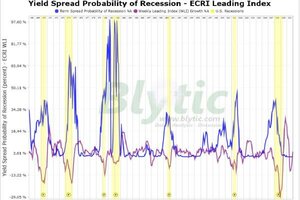Another recession? Here's what indicators really say.
Two leading indicators point to continued growth, not recession.

Two leading indicators suggest a recession is not in the cards anytime soon.
SoldAtTheTop
With much of the econ-finance talk these days still centered around the possibility of a looming “double-dip” let’s take a closer look at two particularly sensitive and accurate leading indicators of our economic health to see if we can tease out the future trends.
First, the Federal Reserve Bank of New York is known to use the yield curve (or more specifically the spread between the 10 year and the 3 month treasury yields) to calculate a probability of recession.
This method appears to have been spearheaded by Professor Arturo Estrella of the Rensselaer Polytechnic Institute and Professor Frederic Mishkin of the Columbia Business School as outlined in the June 1996 issue of Current Issues in Economic and Finance, a journal published by the Federal Reserve Bank of New York.
The yield curve probability method is said to have a nearly perfect track record at predicting recessions some two to six quarters ahead with only one false positive, a period in 1967 that many economists, most notably the late Milton Friedman, considered to have been a credit crunch/mini-recession even though the NBER does not officially recognize it as such.
Another important leading indicator with a solid track record is the Economic Cycle Research Institutes (ECRI)weekly leading indicator (WLI).
When the growth component of the WLI turns strongly negative (< -6) it generally means a notable slowdown or recession is in the offing. So what are these two important indicators saying about our current economic situation? The yield curve spread indicator is indicating that the probability of recession is nearly zero while the ECRI leading index is showing some strengthening signs with the growth component currently at a tepid level of 4.1.
Add/view comments on this post.
------------------------------
The Christian Science Monitor has assembled a diverse group of the best economy-related bloggers out there. Our guest bloggers are not employed or directed by the Monitor and the views expressed are the bloggers' own, as is responsibility for the content of their blogs. To contact us about a blogger, click here. To add or view a comment on a guest blog, please go to the blogger's own site by clicking on the link above.
